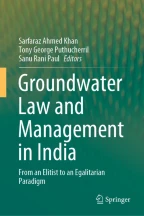
Since it is physical laws and geological conditions that determine groundwater’s nature, and its movement, the legal system has been struggling to regulate this resource’s quantity and quality dimensions in the public interest. For a long time, effective legal control was not possible because of the lack of scientific knowledge regarding the underground water movement. The law had to grope in the dark, and groundwater rights were based on the English common law principles based on the absolute land ownership doctrine. Groundwater rights came to be recognized as an incident of the right of ownership of the overlying land. With the growth in hydrological science and scientific methods, particularly mathematical modelling, it is now possible to determine groundwater behaviour. Despite this, India continues to adhere to colonial precepts relating to groundwater management steadfastly. There is also recognition that there is hydrological connectivity between groundwater and surface water; therefore, groundwater is a relevant factor in equitably apportioning surface waters. The Supreme Court of India, while applying the rules of equitable apportionment in the Cauvery water dispute, has considered groundwater as a factor and has accounted for the same. This chapter provides an overview of India’s groundwater scenario and examines some of the drawbacks of the present legal system on groundwater management. It will also analyze groundwater’s importance in equitably allocating surface water between a federation’s competing units.
This is a preview of subscription content, log in via an institution to check access.
eBook EUR 117.69 Price includes VAT (France)
Softcover Book EUR 158.24 Price includes VAT (France)
Hardcover Book EUR 158.24 Price includes VAT (France)
Tax calculation will be finalised at checkout
Purchases are for personal use only